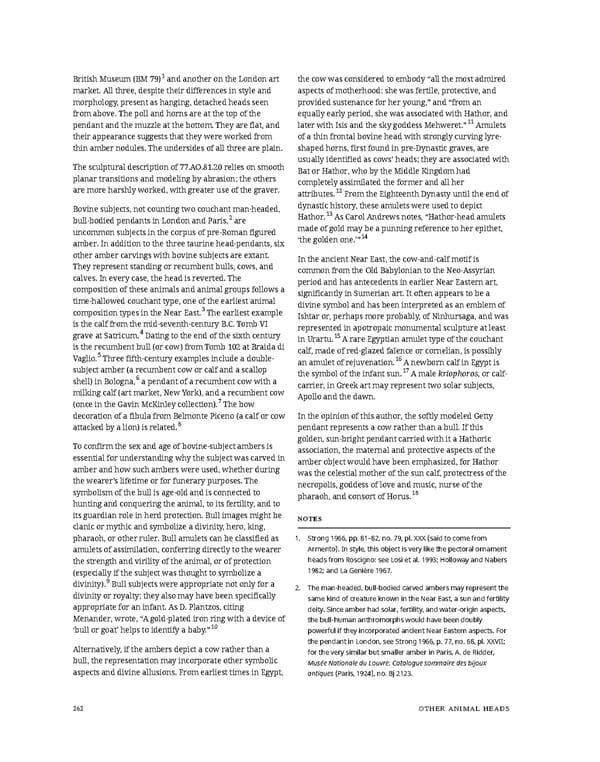British Museum (BM 79)1and another on the London art the cow was considered to embody “all the most admired market. All three, despite their differences in style and aspects of motherhood: she was fertile, protective, and morphology, present as hanging, detached heads seen provided sustenance for her young,” and “from an from above. The poll and horns are at the top of the equally early period, she was associated with Hathor, and pendant and the muzzle at the bottom. They are flat, and later with Isis and the sky goddess Mehweret.”11 Amulets their appearance suggests that they were worked from of a thin frontal bovine head with strongly curving lyre- thin amber nodules. The undersides of all three are plain. shaped horns, first found in pre-Dynastic graves, are usually identified as cows’ heads; they are associated with The sculptural description of 77.AO.81.20 relies on smooth Bat or Hathor, who by the Middle Kingdom had planar transitions and modeling by abrasion; the others completely assimilated the former and all her are more harshly worked, with greater use of the graver. attributes.12 From the Eighteenth Dynasty until the end of Bovine subjects, not counting two couchant man-headed, dynastic history, these amulets were used to depict 2 Hathor.13 As Carol Andrews notes, “Hathor-head amulets bull-bodied pendants in London and Paris, are uncommon subjects in the corpus of pre-Roman figured made of gold may be a punning reference to her epithet, ‘the golden one.’”14 amber. In addition to the three taurine head-pendants, six other amber carvings with bovine subjects are extant. In the ancient Near East, the cow-and-calf motif is They represent standing or recumbent bulls, cows, and common from the Old Babylonian to the Neo-Assyrian calves. In every case, the head is reverted. The period and has antecedents in earlier Near Eastern art, composition of these animals and animal groups follows a significantly in Sumerian art. It often appears to be a time-hallowed couchant type, one of the earliest animal divine symbol and has been interpreted as an emblem of composition types in the Near East.3 The earliest example Ishtar or, perhaps more probably, of Ninhursaga, and was is the calf from the mid-seventh-century B.C. Tomb VI represented in apotropaic monumental sculpture at least grave at Satricum.4 Dating to the end of the sixth century 15 in Urartu. A rare Egyptian amulet type of the couchant is the recumbent bull (or cow) from Tomb 102 at Braida di calf, made of red-glazed faïence or cornelian, is possibly Vaglio.5 Three fifth-century examples include a double- 16 an amulet of rejuvenation. A newborn calf in Egypt is subject amber (a recumbent cow or calf and a scallop the symbol of the infant sun.17 A male kriophoros, or calf- shell) in Bologna,6 a pendant of a recumbent cow with a carrier, in Greek art may represent two solar subjects, milking calf (art market, New York), and a recumbent cow Apollo and the dawn. (once in the Gavin McKinley collection).7 The bow decoration of a fibula from Belmonte Piceno (a calf or cow In the opinion of this author, the softly modeled Getty attacked by a lion) is related.8 pendant represents a cow rather than a bull. If this golden, sun-bright pendant carried with it a Hathoric To confirm the sex and age of bovine-subject ambers is association, the maternal and protective aspects of the essential for understanding why the subject was carved in amber object would have been emphasized, for Hathor amber and how such ambers were used, whether during was the celestial mother of the sun calf, protectress of the the wearer’s lifetime or for funerary purposes. The necropolis, goddess of love and music, nurse of the symbolism of the bull is age-old and is connected to pharaoh, and consort of Horus.18 hunting and conquering the animal, to its fertility, and to its guardian role in herd protection. Bull images might be NOTES clanic or mythic and symbolize a divinity, hero, king, pharaoh, or other ruler. Bull amulets can be classified as 1. Strong 1966, pp. 81–82, no. 79, pl. XXX (said to come from amulets of assimilation, conferring directly to the wearer Armento). In style, this object is very like the pectoral ornament the strength and virility of the animal, or of protection heads from Roscigno: see Losi et al. 1993; Holloway and Nabers (especially if the subject was thought to symbolize a 1982; and La Genière 1967. divinity).9 Bull subjects were appropriate not only for a divinity or royalty; they also may have been specifically 2. The man-headed, bull-bodied carved ambers may represent the same kind of creature known in the Near East, a sun and fertility appropriate for an infant. As D. Plantzos, citing deity. Since amber had solar, fertility, and water-origin aspects, Menander, wrote, “A gold-plated iron ring with a device of the bull-human anthromorphs would have been doubly ‘bull or goat’ helps to identify a baby.”10 powerful if they incorporated ancient Near Eastern aspects. For Alternatively, if the ambers depict a cow rather than a the pendant in London, see Strong 1966, p. 77, no. 68, pl. XXVII; for the very similar but smaller amber in Paris, A. de Ridder, bull, the representation may incorporate other symbolic Musée Nationale du Louvre: Catalogue sommaire des bijoux aspects and divine allusions. From earliest times in Egypt, antiques (Paris, 1924), no. Bj 2123. 262 OTHER ANIMAL HEADS
 Ancient Carved Ambers in the J. Paul Getty Museum Page 271 Page 273
Ancient Carved Ambers in the J. Paul Getty Museum Page 271 Page 273